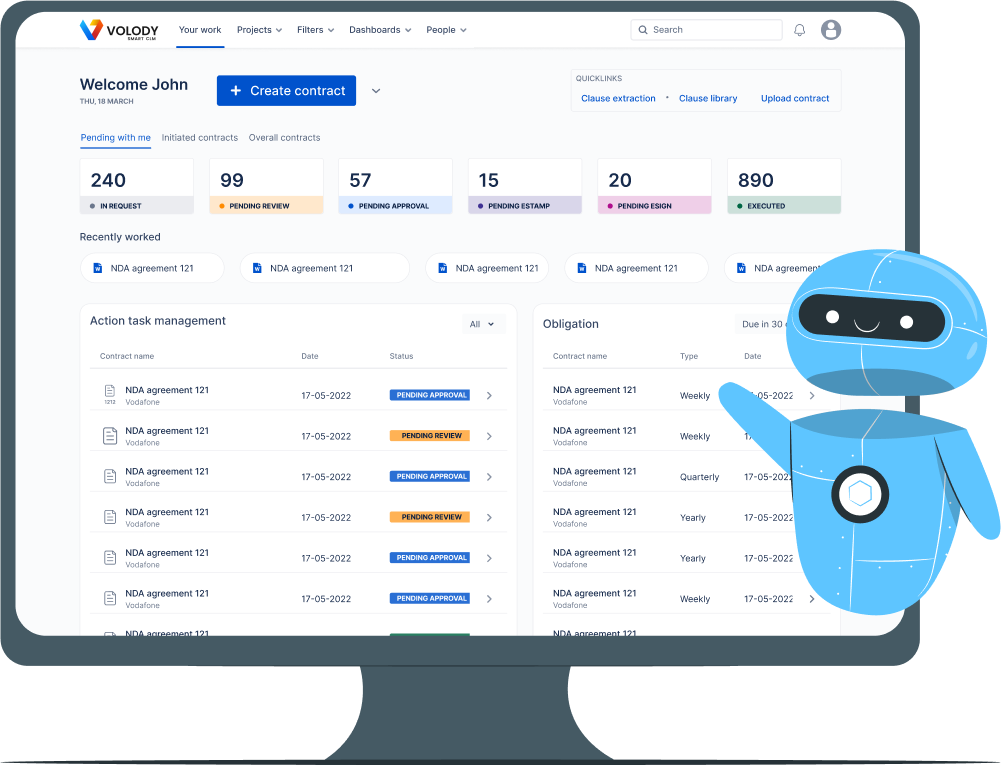Managing multiple versions of contracts is a complex but essential task for businesses of all sizes. Contracts change over time, whether through ongoing negotiations, modifications, or renewals. With each new version, it becomes more challenging to keep track of what’s been added, removed, or altered. Poor version control can lead to significant issues, such as outdated terms, missed obligations, or even legal disputes, as teams might end up working with the wrong information. Effective version tracking, on the other hand, ensures that everyone is on the same page, with access to the most current terms and a full history of changes.
This guide will explore practical strategies for managing contract versions efficiently. You’ll discover best practices such as using naming conventions, leveraging technology, and implementing audit trails, along with key tools and challenges in contract version management. By the end, you’ll have a roadmap to improve your contract version control practices, protect your organization, and streamline operational efficiency.
How to Effectively Track Legal Contract Versioning?
Effectively tracking legal contract versioning involves creating a structured system that maintains an organized record of all contract changes. Here are some steps and tools that can help:
- Establish Naming Conventions: Assign a consistent naming system for each contract versioning, such as “ContractName_v1,” “ContractName_v2,” and so on. This minimizes confusion over which version is the latest and allows easy identification.
- Version Control Features: Rely on features like redlining, comments, and time-stamping within Contract Management Software to record each change and who made it. Redlining also provides visibility into edited sections, improving accuracy and transparency.
- Audit Trail and Permissions: Set up an audit trail that logs who accessed or modified the document. Permission settings ensure that only authorized individuals can make changes, safeguarding the integrity of the contract.
- Centralized Document Repository: Store contracts in a central, cloud-based repository accessible to all relevant parties. This avoids issues with multiple copies and ensures everyone is working from the latest version.
- Regular Reviews and Approval Processes: Implement a review workflow for each new version to confirm that all edits are aligned with legal standards and company policies. Define approval steps to prevent premature execution of incomplete drafts.
Related Article: Best Contract Management Software: Top 10 CLM in 2024
Why Effective Contract Versioning Control Matters

Contract version control is not just about organization. It plays a significant role in reducing legal and financial risks. Using an outdated contract version could lead to missed obligations or legal disputes. A clear version history protects your organization by showing a record of changes and approvals, which is useful during audits or compliance checks.
By ensuring that all team members access the latest version, businesses avoid misunderstandings and foster a productive, efficient workflow. This leads to faster contract execution, fewer delays, and smoother business operations overall.
Reducing Legal Risks with Accurate Version Tracking
A complete audit trail creates a clear record of what was agreed upon and when. Tracking each change, its timing, and the person responsible ensures a reliable history of the contract’s progression.
Without accurate version control, businesses risk breaching contracts by inadvertently accepting outdated terms or missing key updates. A robust version-tracking system provides transparency and trust, reducing misunderstandings and keeping stakeholders aligned.
Improving Efficiency with Streamlined Version Control
When teams waste time locating the correct contract version or correcting errors, it drains resources. A streamlined version control process eliminates these inefficiencies and keeps everyone focused on their work.
By implementing a well-organized version control system, businesses can optimize the contract lifecycle from drafting through negotiation, approvals, and renewals. All stakeholders can access the latest version instantly, boosting productivity and collaboration.
Related Article: Ultimate guide to Contract Repository Systems
Using Technology for Improved Contract Versioning Management

Traditional contract management relied on shared drives and manual processes to manage versions—systems prone to errors and inconsistencies. Today, dedicated contract management software automates much of this work, creating a central location for collaboration, version tracking, and real-time changes with clear audit trails.
These tools offer a safer, more efficient system, allowing businesses to leave behind cumbersome manual methods and embrace modernized contract version control.
The Role of Contract Lifecycle Management (CLM) Systems
CLM Software is important for managing contracts effectively. They create an audit trail that keeps track of all changes made to a contract. This helps stakeholders see modifications and access previous versions easily. CLM systems also use naming rules and set permissions to stop unauthorized changes. This helps keep contract versions consistent. By connecting CLM systems with contract storage like SharePoint or OneDrive, contract management becomes simpler. It allows all versions to be stored in one place for future reference and renewal.
How can Volody help in contract versioning

Volody is a powerful contract lifecycle management (CLM) solution designed to streamline the entire process of managing contracts, from creation to execution and beyond. With a focus on enhancing collaboration and ensuring compliance, Volody provides users with tools to efficiently track and manage contract versions, making it easier to navigate the complexities of contract management. Here’s how Volody can specifically assist with contract versioning:
- Version Control: Volody provides robust version control, allowing users to create, edit, and save multiple versions of contracts seamlessly. This ensures that all changes are tracked, and previous versions can be easily accessed when needed.
- Audit Trails: With built-in audit trails, Volody keeps a comprehensive history of all edits and updates made to contracts. Users can view who made changes and when enhancing accountability and transparency.
- Notifications and Alerts: Users can set up notifications to be alerted when a contract is modified. This keeps all stakeholders informed about changes in real-time, reducing the risk of working from outdated versions.
- Centralized Repository: Volody offers a centralized repository for all contract documents, making it easy to find and manage different versions in one location, rather than having them scattered across various platforms or folders.
- Comparison Tools: The software includes tools that allow users to compare different versions of a contract side by side. This feature highlights changes, making it easier to review modifications and ensure accuracy.
- Collaboration Features: Volody facilitates collaboration by allowing multiple users to work on contract versions simultaneously. Comments and suggestions can be made directly on the document, streamlining communication.
- Search Functionality: Advanced search capabilities enable users to quickly find specific versions or clauses within contracts, saving time and improving efficiency.
- Templates and Standardization: By providing templates, Volody ensures that all contract versions adhere to company standards, making it easier to manage and maintain consistency across documents.
Analytics and Reporting: Users can generate reports on contract versioning activity, providing insights into how contracts are being managed and identifying areas for improvement in the process.
Best Practices for Contract Version Control

No matter how you choose to manage your contracts – with software or by hand – following best practices is key for good contract version control. When you use these practices, you build a system that cuts down on mistakes. It also helps people work together better and makes sure everyone is informed.
First, set a clear naming convention for all contract versions. This easy step removes confusion and helps you find the right version quickly. Next, create a strong approval process for any contract changes. This means all changes should be properly checked and approved to keep your documents accurate.
Establishing a Standard Operating Procedure for Version Updates
Implementing a standard operating procedure (SOP) helps reduce confusion and cut down on mistakes during the contract lifecycle. Write down each step. This includes making new versions, getting approvals, and sharing the updated document.
A good SOP defines responsibilities. This way, everyone involved in the contract management understands their role in version control. Assign who will update contracts and decide who can approve changes.
Also, create a standard naming convention for all contract versions. This will help avoid mix-ups and make documents easy to recognize. Make sure to include the contract name, version number, date, and a short description of any changes made.
Regular Audits and Compliance Checks for Version Integrity
Regular audits are crucial to ensure that your version control practices are effectively implemented and identify potential areas for improvement. Schedule periodic reviews to examine your version history, confirm adherence to the established naming convention, and verify the accuracy of the audit trail.
Compliance checks are equally critical, especially when handling contracts subject to specific regulations. Regularly review contracts to ensure they align with current legal requirements, industry standards, and internal policies. This proactive approach minimizes risks and prevents costly legal complications.
Consider the following aspects for efficient audits and compliance checks:
|
Aspect |
Description |
|
Version history |
Ensure all modifications are captured with appropriate version numbers and timestamps. |
|
Naming convention |
Verify consistent use of the defined naming convention for easy identification. |
|
Audit trail |
Confirm the accuracy and completeness of the audit trail, tracing every change to its source. |
Related Article: What is an Automatic Contract Renewal Clause? Detailed Guide
In conclusion, good contract version control is very significant. It helps reduce legal risks, improve operations, and keep the correct version of documents. Companies should set up clear procedures, check their work regularly, and use technology like Contract Lifecycle Management systems to make this happen. Keeping track of versions accurately is essential for following rules and being great at managing contracts. Always be active in handling different versions of contracts to avoid mistakes and protect your company’s interests. Focus on smart version control methods to improve your contract management practices.
FAQs
How can organizations ensure all team members use the correct contract version?
Organizations can make sure all team members use the current version by using a contract management platform. This creates a single source of truth. It allows easy access to the latest versions and prevents the use of old copies.
Risks of Poor Contract Version Control for Stakeholders?
Poor contract version control puts organizations at serious legal risk. When there is unauthorized access or if outdated versions are used, it can lead to a breach of contract. This situation puts relationships with stakeholders at risk and can cost a lot of money. It is important to keep track of contract versions to meet contractual obligations and protect organizations.





